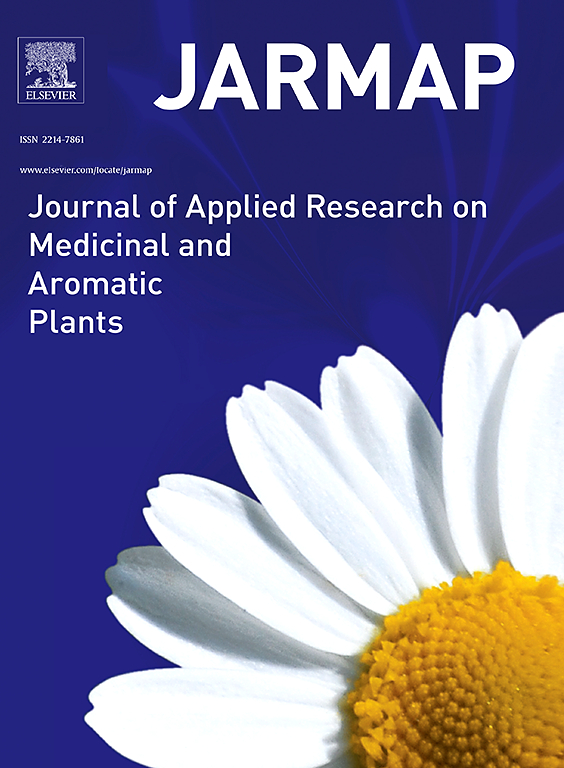Extraction of polyphenolic compounds from rose and marigold, UPLC-ESI-QToF-MS/MS, FTIR characterization and assessment of antioxidant activity
IF 3.6
2区 农林科学
Q1 PLANT SCIENCES
Journal of Applied Research on Medicinal and Aromatic Plants
Pub Date : 2025-02-01
DOI:10.1016/j.jarmap.2024.100608
引用次数: 0
Abstract
This study aimed to optimize the process for effective extraction of polyphenolic compounds, flavanoids and antioxidant activity of rose and marigold leaf (RL, ML) and petal (RP, MP) extracts and to analyse their composition. Various drying methods, such as shade, oven (40–70 °C), and microwave (600 W) were utilized for extraction of bioactives with three solvents (water, ethanol, methanol). Microwave dried methanolic extracted samples exhibited high quantities of total phenols, flavanoids, and antioxidants for RL, ML, and MP, while aqueous extracts were found to be the best for extracting bioactives from RP. As the drying temperature increased, the colour values of the extracts decreased. Pigments (chlorophyll, anthocyanin, carotenoids) degraded when the drying temperature increased. The ultra-performance liquid chromatography (UPLC) and fourier transform infrared (FTIR) analysis revealed the primary polyphenol compounds in rose as quercetin, quercetin 3-O-rutinoside, and kaempferol acetyl disaccharide while in marigold they were identified as kaempferol, epicatechin gallate, and feruloyl-caffeoylquinic acid). Also 126 other polyphenolic compounds were identified putatively from rose and marigold through UPLC-ESI-QToF-MS/MS and FTIR. Marigold and rose foliage accounts for 58 % and 82 % of the entire plant's fresh weight, respectively that is usually disposed off as waste. The floral fraction is typically discarded after it has served its primary function. The process of extracting bioactive compounds from these medicinal crops can enhance their value and yield useful products having varying end-use.
玫瑰和万寿菊中多酚类化合物的提取、UPLC-ESI-QToF-MS/MS、FTIR表征及抗氧化活性评价
本研究旨在优化玫瑰和万寿菊叶片(RL, ML)和花瓣(RP, MP)提取物中多酚类化合物、黄酮类化合物的有效提取工艺,并对其成分进行分析。采用遮阳、烘箱(40-70 °C)和微波(600 W)等多种干燥方法,以水、乙醇、甲醇三种溶剂提取生物活性物质。微波干燥的甲醇提取样品显示出大量的总酚、黄酮类化合物和抗氧化剂,用于RL、ML和MP,而水提取物被发现是提取RP中生物活性的最佳方法。随着干燥温度的升高,提取物的颜色值降低。当干燥温度升高时,色素(叶绿素、花青素、类胡萝卜素)降解。超高效液相色谱(UPLC)和傅里叶变换红外(FTIR)分析表明,玫瑰中的主要多酚类化合物为槲皮素、槲皮素3- o -芦丁苷和山奈酚乙酰二糖,万寿菊中的主要多酚类化合物为山奈酚、表儿茶素没食子酸酯和阿魏酰咖啡酰奎宁酸。另外,通过UPLC-ESI-QToF-MS/MS和FTIR等方法从玫瑰和万寿菊中鉴定出126种多酚类化合物。金盏花和玫瑰的叶子分别占整个植物鲜重的58% %和82, %,通常作为废物处理掉。花的部分通常在完成其主要功能后被丢弃。从这些药用作物中提取生物活性化合物的过程可以提高它们的价值,并产生具有不同最终用途的有用产品。
本文章由计算机程序翻译,如有差异,请以英文原文为准。
求助全文
约1分钟内获得全文
求助全文
来源期刊

Journal of Applied Research on Medicinal and Aromatic Plants
Pharmacology, Toxicology and Pharmaceutics-Drug Discovery
CiteScore
6.40
自引率
7.70%
发文量
80
审稿时长
41 days
期刊介绍:
JARMAP is a peer reviewed and multidisciplinary communication platform, covering all aspects of the raw material supply chain of medicinal and aromatic plants. JARMAP aims to improve production of tailor made commodities by addressing the various requirements of manufacturers of herbal medicines, herbal teas, seasoning herbs, food and feed supplements and cosmetics. JARMAP covers research on genetic resources, breeding, wild-collection, domestication, propagation, cultivation, phytopathology and plant protection, mechanization, conservation, processing, quality assurance, analytics and economics. JARMAP publishes reviews, original research articles and short communications related to research.
 求助内容:
求助内容: 应助结果提醒方式:
应助结果提醒方式:


